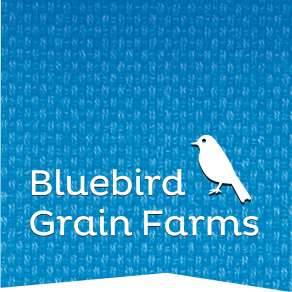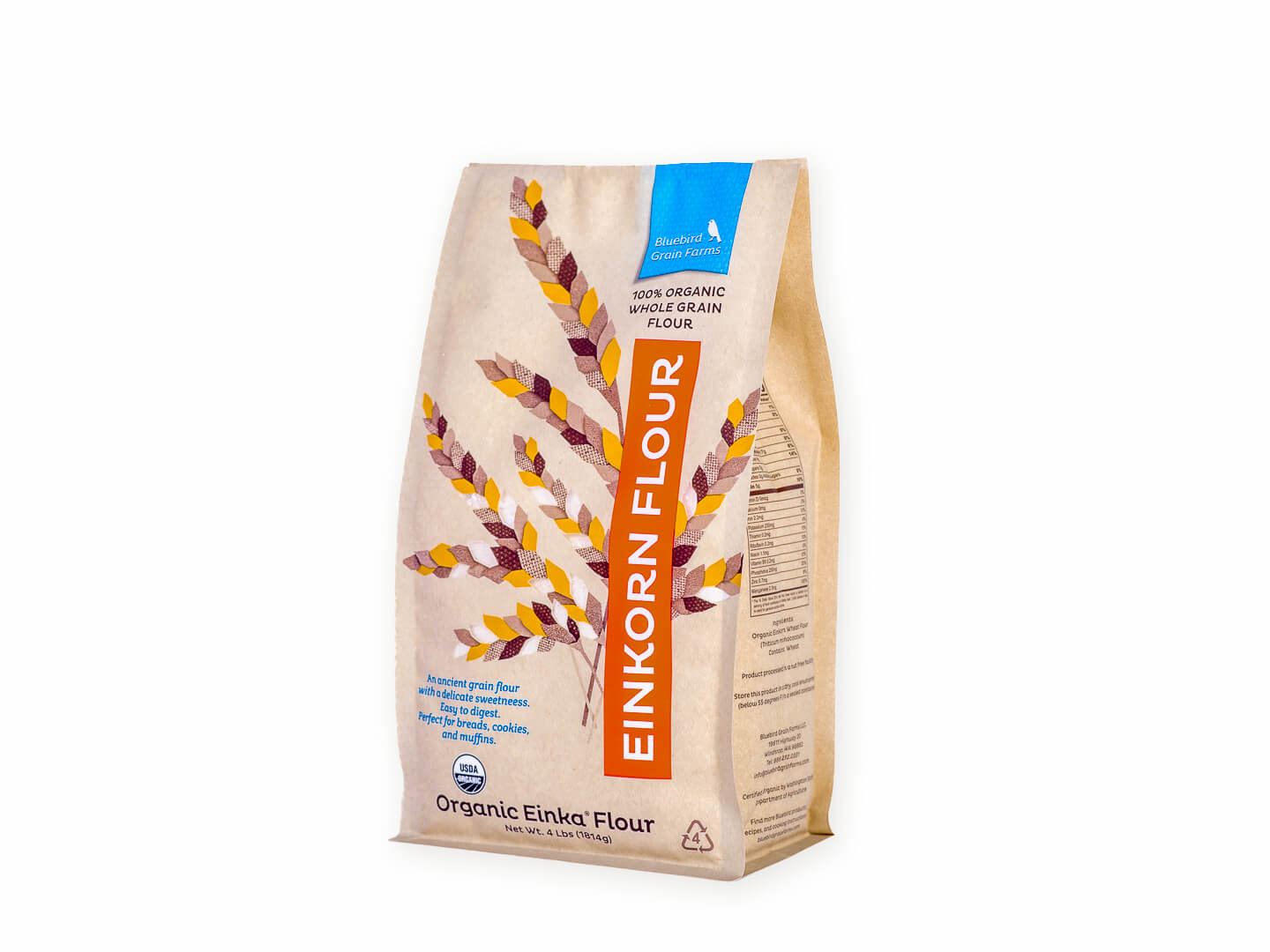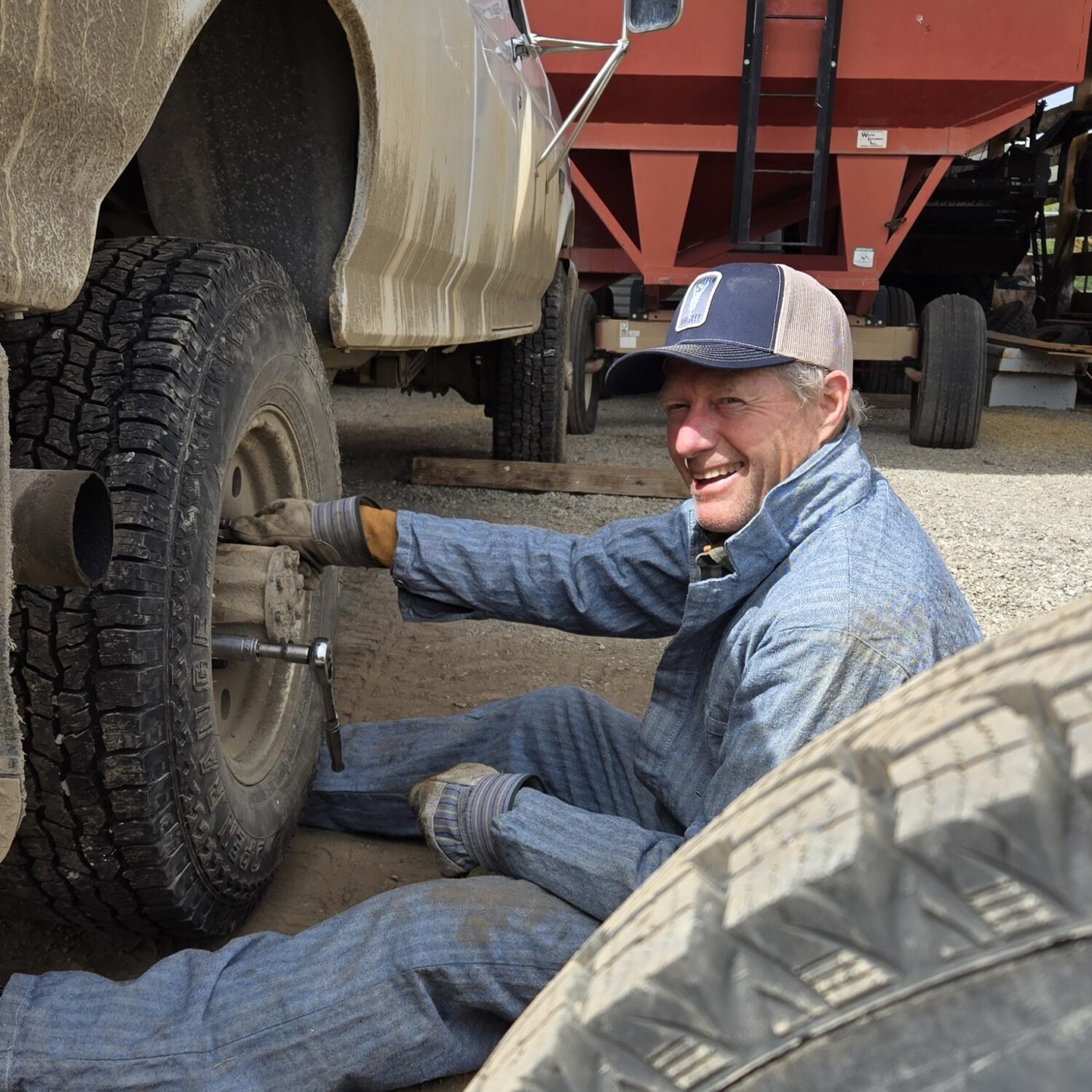
Well it hasn’t been a very quiet week, or month, here at Bluebird Grain Farms. We welcome back the wrens, the warblers, bluebirds, finches, ducks, geese while balsamroot and lupine bloom across the foothills. April’s full “Pink Moon” brought out the coyotes as the voice of spring frogs drifted from nearby vernal pools. As I jot these notes here at the end of April, heavy clouds hang about the sky and one good downpour has just finished. We will take another just like it! April showers…
Both the flour mill and the grain cleaning line have been humming right along as a variety of orders ranging from 1 ton totes down to 1 pound bags leave the granary daily. This spring bustle has likely been brought on by a series of things as overall grain supplies can become lean with the 2023 harvest well in the past. Not everyone can plan precisely for annual needs; this goes for both consumers and suppliers alike and Bluebird often sees an uptick of interest in our own supply. Sometimes we end up servicing new customers due to shortages elsewhere. Sometimes a few of these customers become long-timers!
Consumer and supplier; concerns over this relationship have only grown as America’s subsidized food system once more appears to be flailing. Most recently, the Avian Flu outbreak has reared up again and this time is spreading first to dairy cows, then to the milk itself. Now, the meat supply chain is suspect. Probable cause: Cows (ungulates) being fed chicken byproduct. Carcass scraps are ground and mixed in with various other surplus, cheap feeds (byproduct). Hmmm.
Mentioning cows, the West faces another season of drought in many regions. Biggest water users? Cows. Eighty percent of western water goes to thirsty livestock crops such as alfalfa. Meanwhile, Bayer Crop Sciences after making a horrible decision to acquire Monsanto just before all the glyphosate (Round Up) lawsuits hit, now wants the government’s and yes, your sympathy? They are pushing back against 100’s of lawsuits brought on by inadequate warning labels, and users themselves that have fallen ill with cancer. Glyphosate is one chemical that is used on much of the nation’s croplands. Although these things may seem distant from Bluebird Grain Farms, in large they drive what we do.
In last month’s notes I mentioned visiting our friends the Schmaltz family on their 5,000 acre organic farm in North Dakota. One might think there isn’t much farming to see in early March on the northern prairie, yet on a healthy farm such as the Schmaltz’s there are all kinds of things to see. Despite being a snowless and dry winter there – what locals call an open winter – just before we arrived it snowed 4-5 inches. Our first morning following an emmer pancake breakfast, we bundled up and left Blaine and Suzie’s cozy farm house for some of their fields. Along their boundaries were neighboring operations that the Ag industry calls “conventional farms”.
That fast, we noticed that the adjacent fields, most fall tilled, had already lost the new snow. (Sometimes it’s windy in North Dakota!) Next, we noticed the snow had all lodged up in Blaine’s fields full of emmer stalks, sunflower stalks, cornstalks. Because he has been working for years toward minimal till and full scale Regenerative Agriculture, the Schmaltz’s farm is now working for itself on a variety of levels. Here, it was working for critical moisture and it really didn’t even have to work!
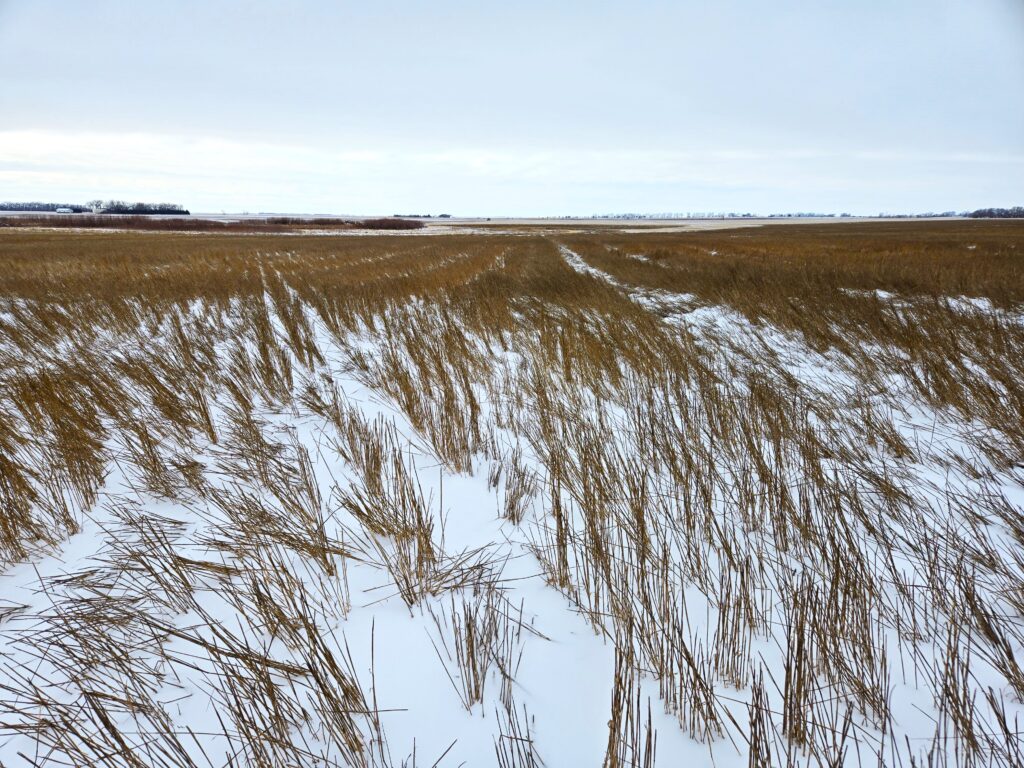
Stalks of harvest Emmer wheat are intentionally left in the ground to hold critical moisture and collect snow.
By leaving the grain stalks standing tall from his combine’s stipper header, not only was blowing snow sequestered here, but the soil itself was sheltered from the cold and the ground hadn’t frozen as deep. Microbial activity in the soil was allowed to continue year-round even in this harshest of climates. Crop residue, and the consequential breakdown thereof builds soil biology. Biologically active soils promote nutrient cycling and give crops available nutrients. Nutrient dense crops give us nutrient-dense food. Moisture sink, carbon sink, biology sink all equal nutrient sink. Nutrient sink equals taste. Let us not forget an important reason we like food!
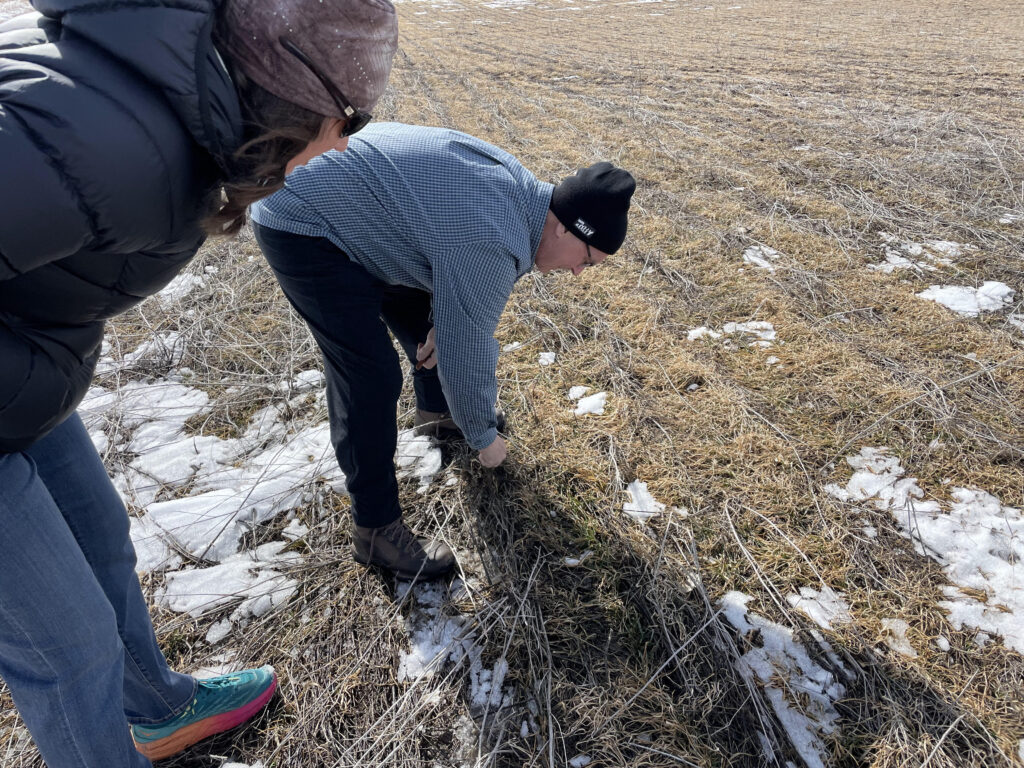
What’s more, out on the Schmaltz’s farm this year-round crop recycling mimics natural grasslands, and what the prairie must have been like before it was farmed. Protected soils warm up earlier in the spring than those left tilled. Spring planting and subsequent growth can thus begin earlier than on the bare soils nearby. Conversely, in the sticky heat of a hot summer’s day Blaine’s soils are shaded and kept cooler resulting in less evaporation. All of this plays into the finished crop: It’s health, it’s yields, and ultimately how it stacks up nutritionally. We are talking about real food grown as close to Nature’s ways as possible.
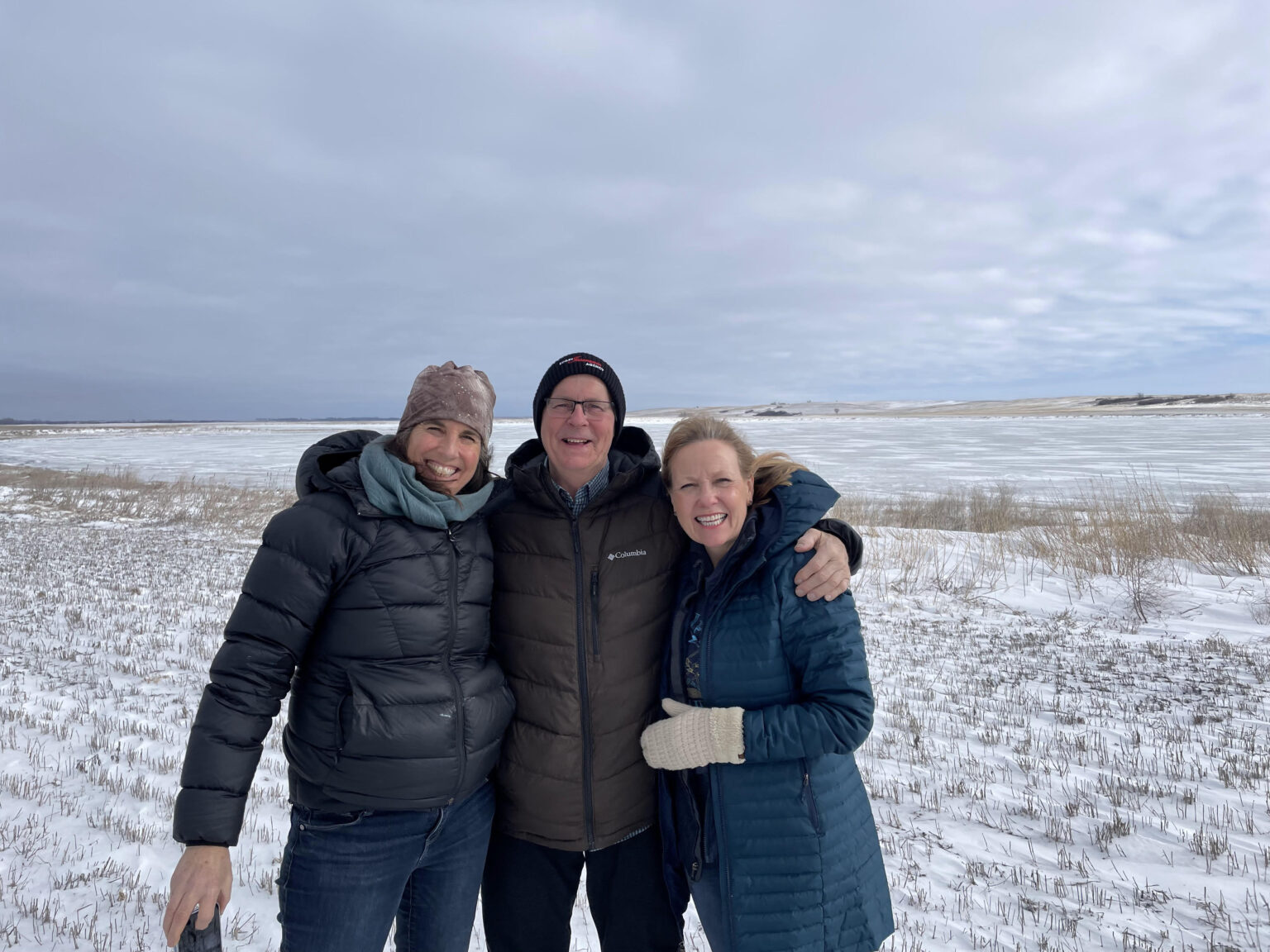
Brooke, Blaine, and Suzie in North Dakota
Some long-time customers might have worried when I made the gradual transition away from full crop production in our tiny valley here. We still farm here to a degree, but this productive and resilient farm system played out on a much vaster scale at the Schmaltz farm is how and where Bluebird emmer is now grown. We feel fortunate indeed and think it is reason to celebrate. This is not only a celebration of a healthy farm system and consistent supply of top grade emmer, but of long term and sustainable human relationships as well. Producer/Processor. Supplier/Consumer. All of which is truly a celebration and appreciation of the Earth itself.
So nothing really has changed here at Bluebird. When you receive your grains from us, you can rest assured we still have health in mind as we have from the very beginning, of both people and the land.
Hello May. Full on planting season! With the growing daylight and heating degree days, the growing season begins as the soils soften and the earth comes alive. Here’s to your health,
Yours,
Farmer Sam
